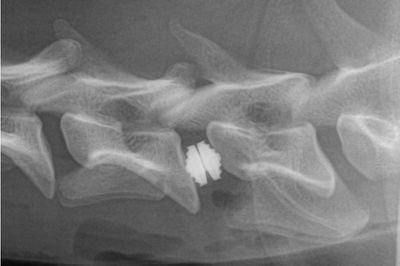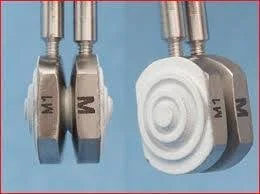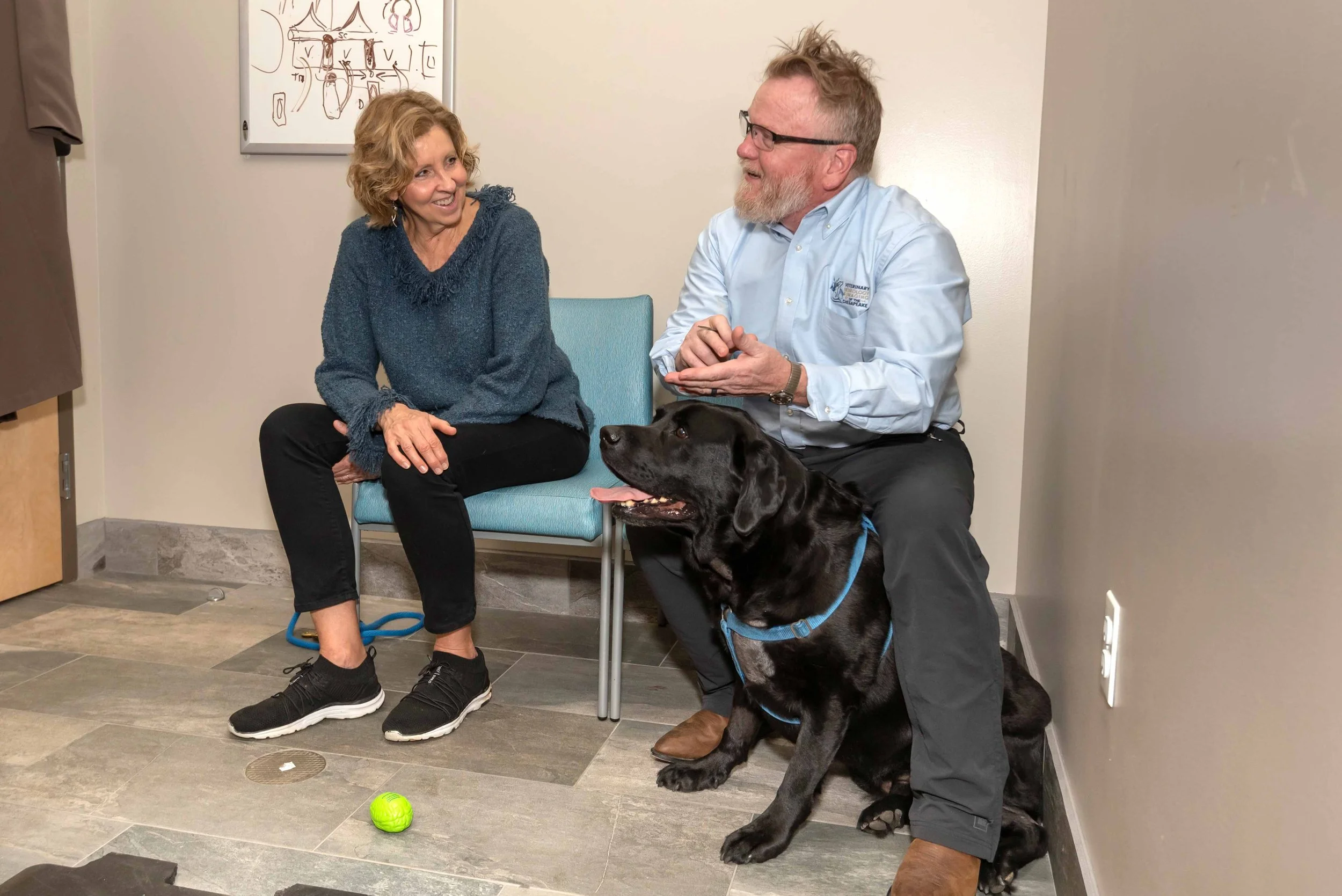NEUROLOGICAL DISEASES IN PETS:
Cervical Spondylomyelopathy (CSM) or Wobbler Syndrome
Caudal cervical spondylomyelopathy (CSM), or Wobblers Syndrome, is a disease of the cervical spine (base of the neck) that is commonly seen in large and giant-breed dogs, especially Doberman Pinschers, Rottweilers, and Great Danes. Other common names for CSM include: Cervical Vertebral instability, Cervical Malformation/Matriculation Syndrome, Disc Associated Wobbler’s Syndrome.
CSM is characterized by osseous (or bony) compression of the spinal cord and/or nerve roots, which leads to neurological signs and/or neck pain. The term wobbler syndrome is used to describe the characteristic wobbly gait (walk) that affected dogs have.
Has your dog been diagnosed with Wobbler Syndrome?
VNIoC’s Dr. Jay McDonnell — one of the nation’s leading experts on Wobbler Syndrome — is now offering special $75 phone consultations for dogs already diagnosed with Wobbler Syndrome with MRI confirmation.
These consults help determine whether your dog may be a candidate for the Adamo-disc, an innovative artificial disc replacement surgery that offers faster recovery, improved mobility, and better long-term outcomes compared to traditional surgeries.
If your pet has not yet been diagnosed, please call us to schedule a regular neurology consult first.
Dynamic vs. Static Cervical
Spondylomyelopathy (CSM) in Dogs
Wobblers syndrome is typically caused by a combination of factors in both types of the disease. There is most likely a genetic component since we see it in certain breeds and even families of dogs. The precipitating causes include abnormalities in the shape or alignment of the cervical vertebrae, thickening or degeneration of ligaments, and Intervertebral disc herniations.
Dynamic CSM
Also known as Disc-associated Wobbler Syndrome (DAWS), is a particularly devastating disease that affects the cervical and intervertebral discs, causing a narrowing of the cervical canal and compression of the spinal cord. Dynamic spinal cord compression (compression that changes with different positions of the cervical spine) always occurs with any type of compression. In this form the lesion is one that worsens or improves with different positions.
The syndrome affects large breed dogs, especially Doberman Pinschers and Rottweilers, that are 4 to 8 years or older, but it can affect any size, breed or age of dog.
Static CSM
In static CSM, the spinal cord compression usually occurs at C2-3 and C3-4 due to proliferation of the articular facet joints (leading to dorsolateral compression). Vertebral malformation (bony associated compression) is most commonly seen in giant breed dogs, usually in young adult dogs that are less than three years of age. The bony malformation can compress the spinal cord from the top and bottom, from the top and sides, or just from the sides.
Diagnosing Wobbler Syndrome in Dogs
A dog with Wobbler Syndrome typically has a wobbly gait mostly in the hind end, and may walk with its head down (a sign of pain). Oftentimes, the first sign is a reluctance to descend stairs or pain when jumping down from an elevated position (deck, tall bed). In advanced cases, the syndrome can affect all four legs; the dog may appear weak, have trouble rising to a standing position, and buckle over on the front legs. Other symptoms to watch for include:
Neck pain – variable
Difficulty rising to a standing position
Worn toenails, scuffed paws
Uncoordinated gait caused by decreased proprioception
Variable muscle atrophy, especially in forelimbs
Occasionally, the presence of Horner's Syndrome
Worsening of signs when the neck is flexed
A complete physical and neurological examination is needed to diagnose Wobbler Syndrome and assess the location and severity of the problem. Additional tests may include:
Complete blood count, chemistry profile and urinalysis
Survey cervical radiographs
General anesthesia is needed for further work-up
MRI (magnetic resonance imaging), dynamic imaging needed in some cases
CSF tap
MRI is a key tool in the diagnosis of DAWS and post-operative reassessment, as it is able to better define the site, severity and nature of the spinal cord compression than either cervical myelography or CT-myelography can. (Also, as the artificial discs we use in the treatment outline below are made of titanium, MRI scans can be used post-operatively, as well.)
Adeline was 5 years old when she presented extremely painful in the neck and had trouble walking, rising from a laying position, and going down stairs.
This picture shows the typical stance of dogs with Wobbler Syndrome — she is holding her neck straight out and is very careful in moving her head.
Treating Dynamic Wobbler Syndrome (DAWS)
Medical Treatment
Medical treatment consisting of glucocorticosteroids and rest may alleviate some signs of disease, but effects may be temporary and this course of treatment may cause gastroenteritis and cystitis. That is why non-surgical management is only recommended for dogs with mild pathology, i.e. small disc bulges, and very slow disease progression.
Surgical Approaches to Wobbler Syndrome
Traditional Surgical Approach
For many years, surgery has been the gold standard of treatment for Wobbler Syndrome. Surgical approaches have provided far superior outcomes to those of medical treatment. Studies have shown that 81% of dogs treated surgically with ventral slot, dorsal laminectomy, or distraction and fusion improved, while only 45% to 54% of dogs improved with medical treatment.
Cervical Arthroplasty with Artificial Disc
Originally developed by Dr. Filippo Adamo in California, the cervical arthroplasty procedure replaces a cervical disk with an artificial titanium one. This procedure shows excellent results with rapid recovery and return to activity and disc replacement is superior to other surgical procedures such as a ventral slot or rigid stabilization. VNIoC’s own Dr. Jay McDonnell was the first veterinary neurosurgeon in the mid-Atlantic area to perform this surgery.
The cervical arthroplasty surgery involves removing the diseased disk under distraction and placing the artificial disk. The distraction is released and the disk is retained in the disk space. The disk is made from titanium for strength and decreased magnetic artifact (MRI). Two pieces articulate by a ball and socket mechanism and allow 30 degrees of movement.
After the damaged disc is removed, a slot is created in the surrounding vertebrae, then the titanium artificial disc is put in place, keeping the vertebrae separate while allowing normal movement. This is in contrast to disc fusion, which can transfer stress to surrounding areas, causing further damage along the spine.
Not only do we feel this surgery provides a better outcome for Wobbler Syndrome; it is less invasive, requires minimal post-op care and hospitalization, reduces post-op pain and discomfort, has a lower mortality rate, and has a lower cost to the owners.
Other surgical options for DAWS often require long post-operative recovery and follow-up cast care. There is also the risk of “domino lesion,” in which an adjacent intervertebral disk space becomes affected. Similar to a relatively new surgery for back pain in humans, cervical arthroplasty using the artificial disc system treats the disease in a more physiological and biomechanically sound manner. It also prevents domino lesions as the implanted disc provides immediate distraction and maintains mobility at the site, making the development of a new lesion at an adjacent site less likely.
Some dogs that are ambulatory when they come in can be operated and discharged the next day. Ultimately, most dogs return to full normal function after this surgery. In fact, we have treated an active agility dog that was able to return to competition just 2 months after surgery.
Rehabilitation and Exercise Modification for Wobbler Syndrome patients
Rehabilitation is extremely important whether the pet has been treated surgically or is undergoing conservative management. Exercise modification (total rest in the short-term and modified exercise in the long-term) can be coupled with physical therapy, manipulative therapies, laser and ultrasound therapy and hydrotherapy.
Treating Static CSM in dogs
There are fewer surgical options for treating static CSM than dynamic CSM. Typically, the best way to treat static CSM is decompression through a dorsal laminectomy.
Lateral radiograph (x-ray) of a dog's neck showing placement of artificial disks between the 5th and 6th cervical vertebrae. This two-piece articulating disk replaces the diseased disk, maintains distraction (spacing) of the disk space, and allows the two vertebrae to continue to articulate (move) naturally.
This is the complete Adamo Spinal Disc implant. The light-weight disks are made from surgical-grade titanium. The white material on the back of the implants promotes bony fusion between the vertebrae and the implant. The two disks articulate like a ball and socket to allow the two parts of the disk to move relative to one another.
Max: A Wobbler Syndrome Case Study
Six-year-old Max is “a big, beautiful, goofy black Lab,” who is adored by his two humans. Athletic like most Labs, Max is also injury-prone. A year previous, he suffered a neck injury so when Max fell down the steps, the local ER veterinarian near their home in Delaware recommended going to VNIoC for a full work-up, which would include an MRI.
When Max’s parents brought him to VNIoC for the consultation, we immediately noticed gait and reflex abnormalities, which led us to suspect a spinal cord problem. The MRI showed disc-associated Wobbler syndrome (DAWS) involving his C5-6 disk space, which caused compression and gliosis of the spinal cord. Dr. McDonnell proposed performing cervical disk replacement using a titanium artificial disc — a procedure developed by Dr. Filippo Adamo.
Given Max is young and very active, he likely would re-injure his neck so his owners decided to have Dr. McDonnell operate — as it seemed the best option for Max long-term. Max, like most dogs, returned to full normal function after his surgery.
Has your dog been diagnosed with Wobbler Syndrome?
VNIoC’s Dr. Jay McDonnell — one of the nation’s leading experts on Wobbler Syndrome — is now offering special $75 phone consultations for dogs already diagnosed with Wobbler Syndrome with MRI confirmation.
These consults help determine whether your dog may be a candidate for the Adamo-disc, an innovative artificial disc replacement surgery that offers faster recovery, improved mobility, and better long-term outcomes compared to traditional surgeries.
If your pet has not yet been diagnosed, please call us to schedule a regular neurology consult first.





